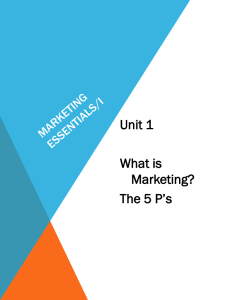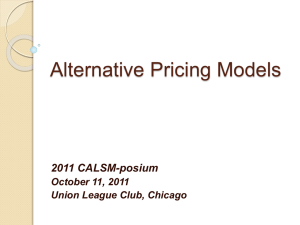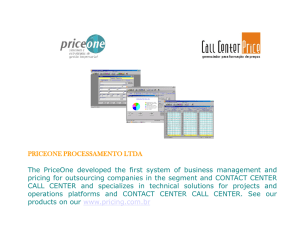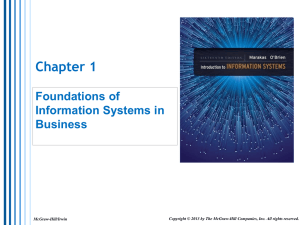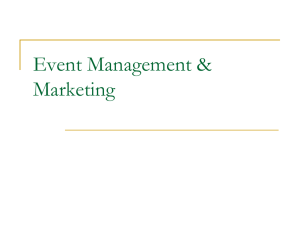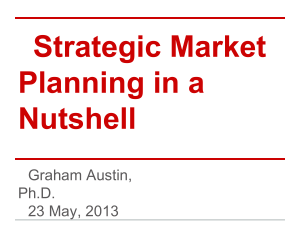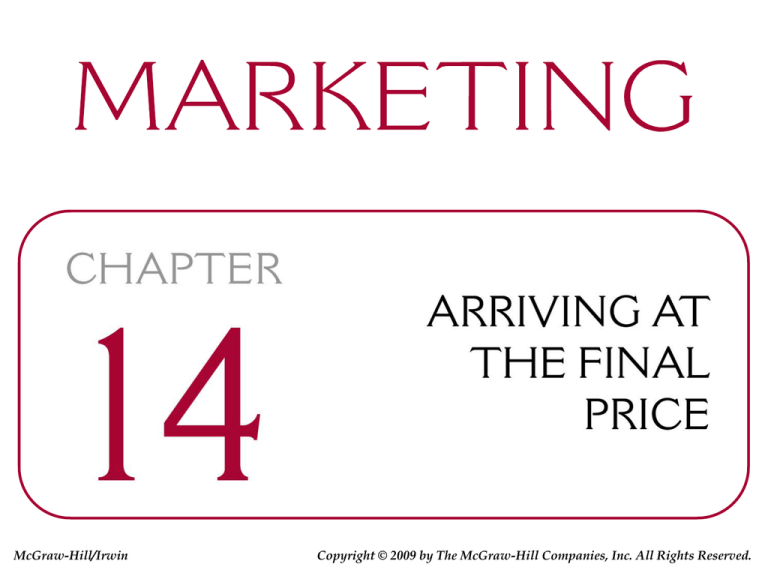
McGraw-Hill/Irwin
Copyright © 2009 by The McGraw-Hill Companies, Inc. All Rights Reserved.
LEARNING OBJECTIVES (LO)
AFTER READING CHAPTER 14, YOU SHOULD BE ABLE TO:
LO1
LO2
Describe how to establish the
“approximate price level” using
demand-oriented, cost-oriented,
profit-oriented, and competitionoriented approaches.
Recognize the major factors
considered in deriving a final list or
quoted price from the approximate
price level.
14-2
LEARNING OBJECTIVES (LO)
AFTER READING CHAPTER 14, YOU SHOULD BE ABLE TO:
LO3
LO4
Identify the adjustments made to the
approximate price level on the basis of
discounts, allowances, and geography.
Name the principal laws and
regulations affecting specific pricing
practices.
14-3
FIGURE 14-1 The six steps in setting price.
The first three steps were covered in
Chapter 13 and the last three steps in
Chapter 14.
14-4
FIGURE 14-2 Four approaches for selecting
an approximate price level
14-5
LO1
STEP 4: SELECT AN
APPROXIMATE PRICE LEVEL
DEMAND-ORIENTED PRICING APPROACHES
Skimming
Pricing
Penetration
Pricing
Prestige
Pricing
Price
Lining
14-6
FIGURE 14-3 Demand curves for two
demand-oriented pricing approaches
14-7
LO1
STEP 4: SELECT AN
APPROXIMATE PRICE LEVEL
DEMAND-ORIENTED PRICING APPROACHES
Odd-Even Pricing
Target Pricing
Bundle Pricing
14-8
Concept Check
1. What are the circumstances in pricing a
new product that might support
skimming or penetration pricing?
A: A firm introducing a new product can
use either skimming pricing to set the
highest initial price that customers
desiring the product are willing to pay
or penetration pricing to set a low
initial price to appeal immediately to
the mass market.
Slide 14-12
Concept Check
2. What is odd-even pricing?
A: Odd-even pricing involves setting
prices a few dollars or cents under
an even number. Psychologically,
a $499.99 price feels lower than
$500.00, even though the difference
is 1¢.
Slide 14-13
STEP 4: SELECT AN
APPROPRIATE PRICE LEVEL
• Cost-Oriented Approaches
– Price is set by looking at the production
and marketing costs and then adding
enough to cover direct expenses,
overhead, and profit
Slide 14-14
STEP 4: SELECT AN
APPROPRIATE PRICE LEVEL
• Cost-Oriented Approaches
Standard Markup Pricing
• Markup on Cost
• Markup on Selling Price
Cost-Plus Pricing
• Cost-Plus Percentage-of-Cost Pricing
• Cost-Plus Fixed-Fee Pricing
– most common in B2B in service sector
Slide 14-14
STEP 4: SELECT AN
APPROPRIATE PRICE LEVEL
• Cost-Oriented Approaches
Standard Markup Pricing
• Markup on Cost
• Markup on Selling Price
Slide 14-14
What Is Markup?
WHAT IS MARKUP?
● Markup
is the dollar amount added to the product
cost to determine its selling price
● Markup is often expressed as a percentage
5-14
WHAT IS PERCENT MARKUP?
$1.00 = cost to retailer
$1.00 = dollar markup
$2.00 = selling price
5-15
WHAT IS PERCENT MARKUP?
● It
depends on whether you use
● Selling
● Cost
Price, or
● Dollar
markup is divided by either selling price or
cost to retailer
5-16
WHAT IS PERCENT MARKUP?
$1.00 = cost to retailer
$1.00 = dollar markup
$2.00 = selling price
•Selling price = 50%
•Cost = 100%
•We use selling price in calculating
the percent of markup
5-17
Example of Markup on Selling Price in
Channel of Distribution
5-18
LO1
STEP 4: SELECT AN
APPROXIMATE PRICE LEVEL
PROFIT-ORIENTED PRICING APPROACHES
Target Profit Pricing
Target Returnon-Sales Pricing
Target Return-onInvestment Pricing
14-20
STEP 4: SELECT AN
APPROPRIATE PRICE LEVEL
Target Profit Pricing – setting an annual target
of a specific dollar volume of profit
Profit = Total revenue – Total Cost
= (P x Q) – [FC + (UVC x Q)]
STEP 4: SELECT AN
APPROPRIATE PRICE LEVEL
Target Return-On-Sales Pricing – setting a
price to achieve a profit that is a
specified percentage of sales volume
STEP 4: SELECT AN
APPROPRIATE PRICE LEVEL
Target Return-On-Investment Pricing – setting
a price to achieve an annual target return on
investment
ROI = Net Profit after taxes / Investment
STEP 4: SELECT AN
APPROXIMATE PRICE LEVEL
LO1
COMPETITION-ORIENTED PRICING APPROACHES
Customary Pricing
Above-, At-, or Below-Market Pricing
Loss-Leader Pricing
14-25
STEP 4: SELECT AN
APPROXIMATE PRICE LEVEL
COMPETITION-ORIENTED PRICING APPROACHES
Customary Pricing – setting a price that is
dictated by tradition, standard channel of
distribution
STEP 4: SELECT AN
APPROXIMATE PRICE LEVEL
COMPETITION-ORIENTED PRICING APPROACHES
Above-, At-, or Below-Market Pricing – setting
market price based on subjective feel for
competitors’ price or market price as the
benchmark
STEP 4: SELECT AN
APPROXIMATE PRICE LEVEL
COMPETITION-ORIENTED PRICING APPROACHES
Loss-Leader Pricing – deliberately setting
price below its customary price, not to
increase sales, but to attract customers’
attention in hopes they will buy other
products as well
LO2
STEP 5: SET THE LIST
OR QUOTED PRICE
CHOOSING A PRICE POLICY
One-Price Policy
Flexible-Price Policy
• Dynamic Pricing
• Clickstream
14-32
STEP 5: SET THE LIST OR
QUOTED PRICE
• One-Price versus Flexible-Price
Policy
One-Price Policy (Fixed Pricing)
Car dealers, “$1 Stores”
Flexible-Price Policy (Dynamic Pricing) –
Setting different prices depending on
individual buyers and purchase situation
• Clickstream
•Viewed as discriminatory
Slide 14-22
STEP 5: SET THE LIST OR QUOTED PRICE
LO2
COMPANY, CUSTOMER, AND
COMPETITIVE EFFECTS ON PRICING
Company Effects
• Product-Line Pricing
Customer Effects
Competitive Effects
• Price War
14-35
FIGURE 14-5 Expected incremental revenue
from pricing and other marketing actions
must more than offset incremental costs to
achieve incremental profit
14-36
FIGURE 14-6 Three special adjustments to
list or quoted price include discounts,
allowances, and geographical adjustments
14-37
LO3
STEP 6: MAKE SPECIAL ADJUSTMENTS
TO THE LIST OR QUOTED PRICE
DISCOUNTS
Discounts
Quantity Discounts
• Noncumulative Quantity Discounts
• Cumulative Quantity Discounts
Seasonal Discounts
14-38
LO3
STEP 6: MAKE SPECIAL ADJUSTMENTS
TO THE LIST OR QUOTED PRICE
DISCOUNTS
Trade (Functional) Discounts
Cash Discounts
14-39
LO3
STEP 6: MAKE SPECIAL ADJUSTMENTS
TO THE LIST OR QUOTED PRICE
ALLOWANCES
Allowances
• Trade-In Allowances
• Promotional Allowances
Everyday Low
Pricing (EDLP)
14-41
LO3
STEP 6: MAKE SPECIAL ADJUSTMENTS
TO THE LIST OR QUOTED PRICE
GEOGRAPHICAL ADJUSTMENTS
FOB Origin Pricing
Uniform Delivered Pricing
• Single-Zone Pricing
• Multiple-Zone Pricing
• FOB with Freight-Allowed Pricing
• Basing-Point Pricing
14-42
FIGURE 14-C Example of basing-point
pricing
14-43
FIGURE 14-8 Several pricing practices are
affected by legal and regulatory restrictions,
which benefit both consumers and firms
14-44
LO4
STEP 6: MAKE SPECIAL ADJUSTMENTS
TO THE LIST OR QUOTED PRICE
LEGAL & REGULATORY ASPECTS OF PRICING
Price Fixing
• Horizontal Price Fixing
• Vertical Price Fixing
Resale Price Maintenance
• Rule of Reason
14-45
LO4
STEP 6: MAKE SPECIAL ADJUSTMENTS
TO THE LIST OR QUOTED PRICE
LEGAL & REGULATORY ASPECTS OF PRICING
Price Discrimination
Deceptive Pricing
14-46
FIGURE 14-9 Five most common deceptive
pricing practices
14-47
LO4
STEP 6: MAKE SPECIAL ADJUSTMENTS
TO THE LIST OR QUOTED PRICE
LEGAL & REGULATORY ASPECTS OF PRICING
Geographical Pricing
Predatory Pricing
14-48
Skimming Pricing
Skimming pricing is used when
introducing a new or innovative
product, and involves setting the
highest initial price that customers
really desiring the product are
willing to pay.
14-49
Penetration Pricing
Penetration pricing involves
setting a low initial price on a
new product to appeal
immediately to the mass market.
14-50
Prestige Pricing
Prestige pricing involves setting
a high price so that quality- or
status-conscious consumers will
be attracted to the product and
buy it.
14-51
Price Lining
Price lining involves setting the
price of a line of products at a
number of different specific
pricing points.
14-52
Odd-Even Pricing
Odd-even pricing involves setting
prices a few dollars or cents under
an even number.
14-53
Target Pricing
Target pricing consists of (1) estimating
the price that ultimate consumers would
be willing to pay for a product, (2) working
backward through markups taken by
retailers and wholesalers to determine
what price to charge wholesalers, and
then (3) deliberately adjusting the
composition and features of the product
to achieve the target price to consumers.
14-54
Bundle Pricing
Bundle pricing involves the
marketing of two or more products
in a single package price.
14-55
Yield Management Pricing
Yield management pricing
involves the charging of different
prices to maximize revenue for
a set amount of capacity at any
given time.
14-56
Standard Markup Pricing
Standard markup pricing
involves adding a fixed
percentage to the cost of all
items in a specific product class.
14-57
Cost-Plus Pricing
Cost-plus pricing involves
summing the total unit cost of
providing a product or service
and adding a specific amount to
the cost to arrive at a price.
14-58
Experience Curve Pricing
Experience curve pricing is a method
of pricing based on the learning effect,
which holds that the unit cost of many
products and services declines by
10 percent to 30 percent each time a
firm’s experience at producing and selling
them doubles, resulting in possible rapid
price reductions.
14-59
Target Profit Pricing
Target profit pricing involves
setting an annual target of a
specific dollar volume of profit.
14-60
Target Return-on-Sales Pricing
Target return-on-sales pricing
involves setting a price to achieve
a profit that is a specified
percentage of the sales volume.
14-61
Target Return-on-Investment Pricing
Target return-on-investment
pricing involves setting a price
to achieve an annual target
return-on-investment (ROI).
14-62
Customary Pricing
Customary pricing involves
pricing setting a price that is
dictated by tradition, a
standardized channel of
distribution, or other competitive
factors.
14-63
Above-, At-, or Below-Market Pricing
Above-, at, or below-market
pricing involves setting a market
price for a product or product
class based on a subjective feel
for the competitors’ price or
market price as the benchmark.
14-64
Loss-Leader Pricing
Loss-leader pricing involves
deliberately selling a product
below its customary price, not
to increase sales, but to attract
customers’ attention in hopes
that they will buy other products
as well.
14-65
One-Price Policy
A one-price policy involves
setting one price for all buyers of
a product or service. Also called
fixed pricing.
14-66
Flexible Price Policy
A flexible price policy involves
setting different prices for
products and services depending
on individual buyers and purchase
situations. Also called dynamic
pricing.
14-67
Product Line Pricing
Product line pricing involves
the setting of prices for all items
in a product line to cover the total
cost and produce a profit for the
complete line, not necessarily for
each item.
14-68
Price War
A price war involves successive
price cutting by competitors to
increase or maintain their unit
sales or market share.
14-69
Quantity Discounts
Quantity discounts are
reductions in unit costs for a
larger order.
14-70
Promotional Allowances
Promotional allowances are
cash payments or extra amount
of “free goods” awarded sellers
in the channel of distribution for
undertaking certain advertising
or selling activities to promote a
product.
14-71
Everyday Low Pricing (EDLP)
Everyday low pricing (EDLP)
is the practice of replacing
promotional allowances with
lower manufacturer list prices.
14-72
FOB Origin Pricing
FOB origin pricing is the “free on
board” (FOB) price the seller quotes
that includes only the cost of loading
the product onto the vehicle and
specifies the name of the location
where the loading is to occur (seller’s
factory or warehouse).
14-73
Uniform Delivered Pricing
Uniform delivered pricing is
the price that the seller quotes
includes all transportation costs.
14-74
Basing-Point Pricing
Basing-point pricing involves
selecting one or more
geographical locations (basing
point) from which the list price for
products plus freight expenses
are charged to the buyer.
14-75
Price Fixing
Price fixing involves a conspiracy
among firms to set prices for a
product.
14-76
Price Discrimination
Price discrimination is the
practice of charging different
prices to different buyers for
goods of like grade and quality.
14-77
Predatory Pricing
Predatory pricing is the practice
of charging a very low price for a
product with the intent of driving
competitors out of business.
14-78


